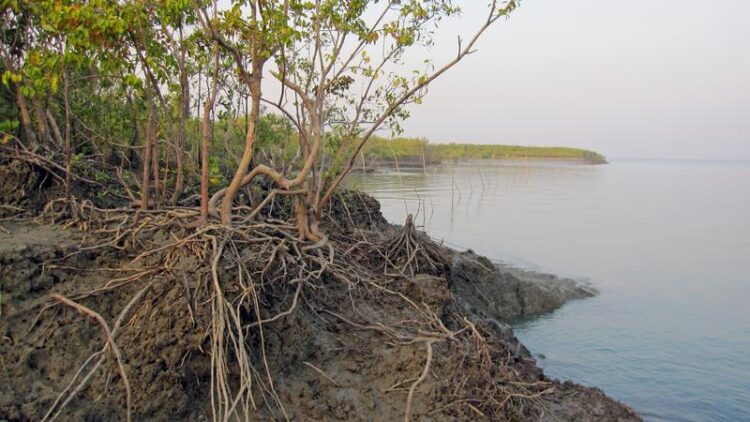What makes mangroves efficient carbon stores?

In the mangroves of the Sundarbans
Bild: Annika Stalling / Leibniz Centre for Tropical Marine Research
The ability of mangroves to store large amounts of CO2 and other climate gases as organic material has sparked increasing interest in this ecosystem. But what must mangrove forests be like to be particularly effective as carbon stores? A new study in Nature Communications provides an answer to this question.
High concentrations of CO2 in the atmosphere and the associated global warming are making us increasingly aware of how imperative it is to conserve our Earth’s carbon stores. The ability of mangroves to store large amounts of CO2 and other climate gases as organic matter in their biomass and sediments has sparked increasing interest in this ecosystem.
Overall, researchers estimate that between four and 20 billion tons of organic carbon are stored in these tidal forests. Mangroves thus contribute significantly to climate change mitigation. However, the amount of carbon varies greatly between regions and mangrove stocks. Until now, it was unclear how mangrove forests must be composed in order to be particularly efficient as carbon reservoirs.
An international research team with participation from the Leibniz Centre for Tropical Marine Research (ZMT) investigated this question in a study in the Sundarbans in Bangladesh. There, in the floodplain of the Brahmaputra and Ganges rivers, one of the largest mangrove forests on earth extends over an area of about 10,000 km². As a UNESCO World Heritage Site, human influences in the Sundarbans are reduced to a minimum.
The study, recently published in Nature Communications, is based on a forest inventory. In 150 forest plots, the species composition of the mangrove stocks was recorded, and the biomass of the trees and the amount of organic carbon stored in the sediment were estimated based on measurements. The researchers then correlated these data with various characteristics of the mangrove forests: the number of tree species, the diversity of their characteristics, and how much the species differed from each other.
The researchers found that the amounts of stored carbon in the plots could be explained in part by the species richness. However, the most important factor was clearly the distinctiveness of species characteristics within a forest plot: the more dissimilar the tree species, the more carbon was stored. In contrast, the diversity of species characteristics played little role.
“On the one hand, our findings confirm the widely held view that biodiversity is good per se, that species richness is a driver of ecosystem processes and services,” explains Prof. Martin Zimmer, mangrove ecologist at the ZMT and co-author of the study. “On the other hand, we found that reforesting mangroves with a few very different species seems to be more goal-oriented than planting many very similar species when it comes to their contribution to climate change mitigation.”
It is known from forests on land that trees in mixed stocks often grow better and produce more biomass. Researchers assume that trees of different species use different resources and thus compete less for food, the more the species differ. With regard to mangroves, they suspect a similar principle.
These findings are very relevant for the protection of mangroves. In the case of damaged or destroyed mangrove forests, reforestation is often the only way to counteract the loss of ecosystem services such as greenhouse gas storage.
“In classic restoration approaches, the goal is to restore a habitat into the state in which it was before it was destroyed,” says Martin Zimmer. “However, having ecosystem services in mind, we have to be clear about which services to promote in particular, and plantings should be designed accordingly.”
Martin Zimmer has developed the concept of “ecosystem design” that could be applied to the protection and restoration of habitats like mangroves. What kind of use and management is allowed, how protection approaches or reforestation are implemented, depends on prioritizing needs. Research on the factors that influence ecosystem services provides the essential basis for this.
Wissenschaftliche Ansprechpartner:
Prof. Dr. Martin Zimmer
Leibniz Centre for Tropical Marine Research (ZMT)
Tel: 0421 / 23800-161
Email: martin.zimmer@leibniz-zmt.de
Originalpublikation:
Rahman MM, Zimmer M, Ahmed I, Donato D, Kanzaki M, Xu M. 2021. co-benefits of protecting mangroves for biodiversity conservation and carbon storage. Nature Communications 12: 3875 (doi.org/10.1038/s41467-021-24207-4)
More information on the concept of ecosystem design
https://www.leibniz-zmt.de/en/news-at-zmt/news/news-archive/international-day-of…
Media Contact
All latest news from the category: Studies and Analyses
innovations-report maintains a wealth of in-depth studies and analyses from a variety of subject areas including business and finance, medicine and pharmacology, ecology and the environment, energy, communications and media, transportation, work, family and leisure.
Newest articles

First-of-its-kind study uses remote sensing to monitor plastic debris in rivers and lakes
Remote sensing creates a cost-effective solution to monitoring plastic pollution. A first-of-its-kind study from researchers at the University of Minnesota Twin Cities shows how remote sensing can help monitor and…

Laser-based artificial neuron mimics nerve cell functions at lightning speed
With a processing speed a billion times faster than nature, chip-based laser neuron could help advance AI tasks such as pattern recognition and sequence prediction. Researchers have developed a laser-based…

Optimising the processing of plastic waste
Just one look in the yellow bin reveals a colourful jumble of different types of plastic. However, the purer and more uniform plastic waste is, the easier it is to…



